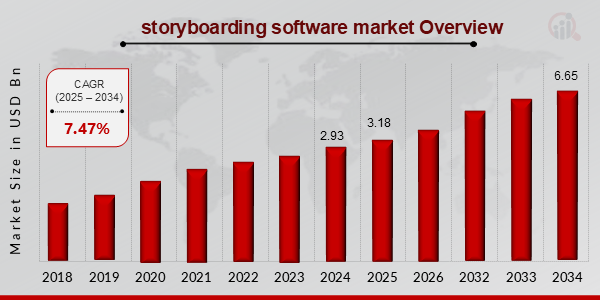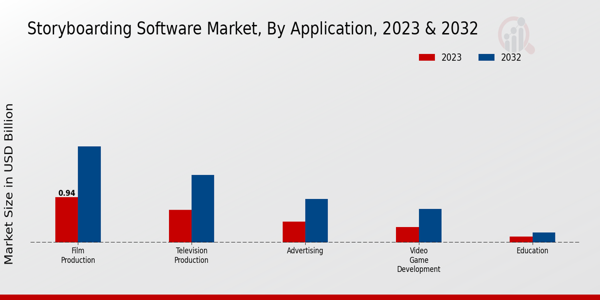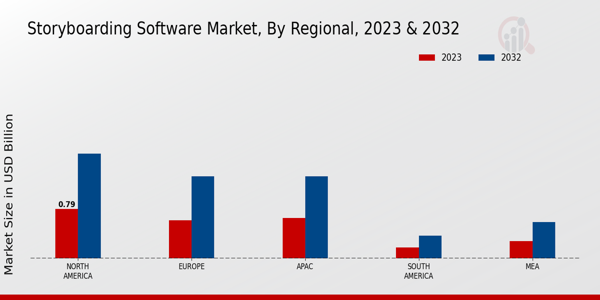Storyboarding Software Market Overview
storyboarding software market is projected to grow from USD 3.18 Billion in 2025 to USD 6.65 Billion by 2034, exhibiting a compound annual growth rate (CAGR) of 8.52% during the forecast period (2025 - 2034). Additionally, the market size for storyboarding software market was valued at USD 2.93 billion in 2024.
Key Storyboarding Software Market Trends Highlighted
The Storyboarding Software Market is experiencing robust growth driven by the increasing demand for visual content across various industries such as film, animation, gaming, and advertising. The rise of digital media consumption and the need for efficient project management tools have propelled the adoption of storyboarding software. These tools streamline the creative process, allowing teams to collaborate effectively and visualize their ideas before final production. Advancements in technology, including cloud computing and artificial intelligence, have further enhanced the functionality of these software solutions, making them more accessible and user-friendly for creators of all skill levels.
There are numerous opportunities to be explored within this evolving market. As more businesses aim to create engaging visual narratives, the demand for customizable and scalable storyboarding tools is likely to increase. Integration of features such as collaboration tools, asset management, and real-time feedback mechanisms can help software providers meet the needs of varied users, from independent filmmakers to large production houses. Additionally, the growing trend of remote work opens avenues for software that facilitates teamwork and project tracking from different locations. This can significantly enhance productivity and creativity, catering to a global audience.
In recent times, there has been a noticeable shift towards online and cloud-based storyboarding solutions, which offer flexibility and easy access to users. With the global emphasis on sustainability, companies are also focusing on reducing their carbon footprint, leading to more digital solutions that minimize physical resources. The growing popularity of mobile applications enables creators to work on the go, thereby expanding the reach of storyboarding tools. Overall, these trends reflect a dynamic market landscape that is adaptable to new technologies and user needs, ensuring sustained interest and investment in storyboarding software solutions.
Figure 1 storyboarding software market Overview (2025-2034)

Source: Primary Research, Secondary Research, MRFR Database and Analyst Review
Storyboarding Software Market Drivers
Increasing Demand for Visual Content Creation
The Storyboarding Software Market Industry is experiencing a surge in the demand for visual content creation as businesses seek to enhance their communication and marketing strategies.
Over the years, viewers have turned towards visual content depictions of videos, presentations and animations as opposed to the traditional approach of relying on textual content as it proves to be much more engaging and appealing. Various different organizations, from advertising agencies to entertainment industries, educational institutions, and even companies specializing in training programs, are using storyboarding computer applications for planning purposes as well as figuring out how their end products are likely to look.
There are several factors contributing to this demand, some of which involve the realization of how powerful such visual stories can be in attracting and keeping people engaged with a brand. In addition to that, there is an increased number of online competitors; hence, as a way to beat the competition, strong visual content must be produced to cut through the digital noise. There is a growing number of companies installing visual communication solutions in their working strategies; thus, as a way to support this trend, more people will be using storyboarding software in the creative process of organizing and developing visual stories.
Such a tendency is not only beneficial for the storyboarding tools market’s growth but also promotes the development of collaborations, cloud sharing, real-time editing, and many other amazing features and possibilities that multitouch the overall user experience. As the demand for storytelling through visual aspects also increases, it’s expected that the Storyboarding Software Market Industry will experience growth as organizations look to upgrade their methods of developing content.
Adoption of Agile Methodologies in Project Management
The shift towards agile methodologies in project management is significantly influencing the Storyboarding Software Market Industry. Agile approaches emphasize flexibility, collaboration, and customer feedback, which resonate with the dynamic requirements of today’s projects. In this context, storyboarding tools facilitate iterative planning and allow teams to visualize their workflows effectively. By providing a structured framework for brainstorming and outlining project narratives, storyboarding software supports agile teams in rapidly adapting to changes and promoting iterative progress.
The increased efficiency and adaptability of these methodologies are fostering greater reliance on storyboarding software as an essential component of agile project management, thus driving market growth.
Technological Advancements and Integration with Other Tools
The Storyboarding Software Market Industry is witnessing enhanced growth with the rapid technological advancements in software development. The integration of artificial intelligence (AI), machine learning, and cloud computing into storyboarding tools is revolutionizing the way projects are planned and executed. Advanced features such as automated layout suggestions, real-time collaboration, and the ability to integrate with other creative software enhance the functionality of storyboarding applications, making them more appealing to users. As organizations increasingly adopt these cutting-edge technologies, the demand for sophisticated storyboarding tools that can seamlessly integrate into existing creative workflows is on the rise, propelling the overall market forward.
Storyboarding Software Market Segment Insights
Storyboarding Software Market Application Insights
The Storyboarding Software Market is undergoing significant growth with a current valuation of 2.49 USD Billion as of 2023, expected to reach 5.2 USD Billion by 2032. This market showcases a diverse range of applications, most prominently in Film Production, Television Production, Advertising, Video Game Development, and Education, reflecting a robust segmentation. Among these, the Film Production segment is notably significant, holding a valuation of 0.94 USD Billion in 2023, and anticipated to expand to 2.0 USD Billion by 2032, demonstrating its majority holding within the overall market landscape.
This reflects the essential role that storyboarding plays in visual storytelling, where detailed planning and execution are critical for success. Television Production also commands a substantial share, valued at 0.68 USD Billion in 2023 and projected to grow to 1.4 USD Billion by 2032. This highlights the need for streamlined production processes, where storyboarding aids in organizing scenes and narratives effectively. Advertising holds a crucial role in the market as well, with a current value of 0.43 USD Billion in 2023 and expected to rise to 0.9 USD Billion by 2032, emphasizing the increasing demand for compelling visuals and structured advertising campaigns in a competitive landscape.
Video Game Development, valued at 0.32 USD Billion in 2023 with a projection to 0.7 USD Billion by 2032, showcases the importance of storyboarding in creating immersive gaming experiences, illustrating the narrative components that engage players. Education, while holding a smaller market share at 0.12 USD Billion in 2023, is expected to grow to 0.2 USD Billion by 2032, underlines the value of storyboarding as a teaching tool for visual literacy and creative thinking, making it a noteworthy segment despite its smaller size. Overall, the Storyboarding Software Market data reveals a diverse application landscape, with each segment playing a critical role in shaping narratives across various industries, illustrating the trends and growth drivers that contribute to its expansion within the market growth.
Figure 2 storyboarding software market Application Insights (2023-2032)

Source: Primary Research, Secondary Research, MRFR Database and Analyst Review
Storyboarding Software Market Deployment Type Insights
The Storyboarding Software Market, valued at 2.49 billion USD in 2023, showcases a diverse Deployment Type segment encompassing Cloud-Based, On-Premise, and Hybrid models. Cloud-Based deployment has gained notable traction among users due to its flexibility and scalability, facilitating real-time collaboration across distributed teams. On-premise solutions remain favored by organizations that prioritize data security and control, contributing significantly to the market. Additionally, the Hybrid model appeals to companies looking to blend the advantages of both cloud and on-premise setups, providing a tailored approach to meet specific operational needs.
The dynamics of the Storyboarding Software Market segmentation underline the evolving preferences of businesses for versatile deployment strategies, which ultimately enhance productivity and creativity in project development. As businesses continue to drive digital transformation initiatives, this segment becomes pivotal to the overall market growth, responding to the increasing demand for efficient and collaborative storyboarding tools. Rising investments in technology further indicate potential expansion and innovation opportunities in the market, thereby shaping future industry standards and practices.
Storyboarding Software Market User Type Insights
The Storyboarding Software Market is witnessing significant growth, particularly influenced by the diverse User Type segment. In 2023, the market was valued at approximately 2.49 billion USD, reflecting the rising demand for storyboarding solutions across varied user categories. The usage among professionals is paramount, as they seek advanced tools to streamline creative processes, enhancing productivity and visual communication. The amateur sector shows a notable increase as hobbyists and enthusiasts embrace storytelling through digital means, which reflects a trend towards more accessible creative platforms.
Educational institutions are also harnessing the capabilities of storyboarding software to facilitate learning and teaching methodologies, ensuring students can effectively visualize concepts. The corporate sector plays a crucial role as well, utilizing these tools for project planning, marketing strategies, and presentations, thereby dominating market interactions. The overall dynamics of the Storyboarding Software Market data indicate robust growth drivers like technological advancements and the rising importance of visual content in various industries, despite challenges related to software adoption and training.The majority of users now leverage the benefits of storyboarding software for efficient project execution and enhanced storytelling.
Storyboarding Software Market End Use Industry Insights
The Storyboarding Software Market, valued at 2.49 USD Billion in 2023, is experiencing growth across various end-use industries, including Entertainment, Education, Marketing and Advertising, and Media and Publishing. The sector of Entertainment is a major driver, often utilizing storyboarding for film and animation production, allowing for better visual planning and effective storytelling. Education also shows significant demand as educators increasingly embrace visual learning tools to enhance student engagement and retention. In the Marketing and Advertising realm, storyboarding plays a crucial role in campaign planning, facilitating clearer communication of ideas and concepts.
Meanwhile, Media and Publishing leverage storyboarding to streamline content creation processes, ensuring cohesive narratives in both print and digital forms. Collectively, these segments contribute to the expanding Storyboarding Software Market revenue, driven by trends towards digital transformation and collaborative workflows. As organizations continue to recognize the value of visual storytelling, the market's segmentation is projected to remain diverse and dynamic, offering ample opportunities amidst challenges such as evolving consumer preferences and technological advancements.
The Storyboarding Software Market data reveals a promising outlook, supported by evolving industry needs and a strong focus on innovation, which drives the overall market growth.
Storyboarding Software Market Regional Insights
The Storyboarding Software Market has shown considerable growth across various regions, with North America holding a majority share valued at 0.785 USD Billion in 2023 and projected to reach 1.661 USD Billion by 2032. This region benefits from advanced technological infrastructure and a high demand for content-creation tools. Europe follows closely, with a valuation of 0.606 USD Billion in 2023, highlighting its significant role in fostering creative industries and digital transformation initiatives. The APAC region, valued at 0.642 USD Billion in 2023, demonstrates rapid adoption of creative software, driven by increasing investment in media and entertainment.
South America and MEA, while comparatively smaller, reflect emerging growth potential, with South America valued at 0.178 USD Billion and MEA at 0.278 USD Billion, showcasing the rising interest in digital content across diverse markets. The combination of these regional insights illustrates a dynamic landscape for the Storyboarding Software Market, where regional variations in demand and technological advancements are shaping market growth trajectories.
Figure 3 storyboarding software market Regional Insights (2023-2032)

Source: Primary Research, Secondary Research, MRFR Database and Analyst Review
Storyboarding Software Market Key Players and Competitive Insights
The Storyboarding Software Market has seen significant growth and transformation driven by the increasing demand for visual storytelling across various sectors such as advertising, filmmaking, education, and UX design. The competitive landscape is characterized by a mix of established players and emerging startups, each vying for a share of the expanding market. Key factors influencing competitiveness include technological advancements, user-friendly interfaces, integrations with other software tools, and the ability to accommodate collaborative workflows. The market is expected to continue evolving, offering opportunities for innovation and new entrants while existing players fortify their positions through strategic alliances and diverse feature sets.
Canva has carved a notable niche within the Storyboarding Software Market by leveraging its intuitive design interface and extensive template library that appeals to both novices and professionals. The platform's strengths lie in its user-centric design approach, making it accessible for individuals with varying degrees of technical skill. With capabilities for collaborative work, Canva enables teams to work seamlessly on projects, thus enhancing productivity and creativity. Its strong brand recognition and extensive marketing efforts further bolster its presence in the market. Canva’s ability to integrate multimedia elements like images, videos, and graphics into storyboards enriches the storytelling process, allowing users to craft visually compelling narratives that resonate with audiences.
Trello distinguishes itself in the Storyboarding Software Market through its unique card-based organizational system that allows users to visually manage projects and ideas effectively. Its strength lies in its flexibility and customization potential, enabling users to create storyboards that align precisely with their workflow needs. With integrations across various productivity tools, Trello enhances collaboration among team members, allowing for real-time updates and progress tracking. This collaborative nature is a major selling point in the market, particularly for teams involved in dynamic environments such as product development or marketing campaigns. Trello’s reputation for simplicity and efficiency in managing complex tasks reinforces its position as a formidable player in the Storyboarding Software Market.
Key Companies in the Storyboarding Software Market Include
- Canva
- Trello
- Celtx
- Boords
- Storyboard Pro
- Plotagon
- Storyboard Fountain
- Blender
- Final Draft
- Scrivener
- Miro
- Adobe
- Toon Boom Animation
- Microsoft
- FrameForge
Storyboarding Software Market Industry Developments
Recent developments in the Storyboarding Software Market have shown significant growth and diversification among key players. Canva has been enhancing its user interface to attract more content creators, while Trello is integrating additional features for project management aimed at various creators, making it more versatile. Celtx is capitalizing on the rising demand for collaborative tools in content creation, and Boords has expanded its functionalities to cater to animators and filmmakers alike. Meanwhile, Storyboard Pro and Toon Boom Animation continue to dominate the animation sector with advanced features that streamline the production process.
Adobe's recent upgrades to its Creative Cloud suite include tools for storyboard creation, reflecting its commitment to staying competitive. There are no major reported mergers or acquisitions among these companies at this time, but the general market valuation is on an upward trend, driven by increased demand for digital storytelling tools across various industries. Miro's recent announcements focus on enhancing collaboration features that appeal to remote teams, indicating a shift in user preferences towards more integrated solutions. This has allowed companies to better align with market needs and innovate further, reinforcing their positions in the growing market landscape.
Storyboarding Software Market Segmentation Insights
-
Storyboarding Software Market Application Outlook
- Film Production
- Television Production
- Advertising
- Video Game Development
- Education
-
Storyboarding Software Market Deployment Type Outlook
- Cloud-Based
- On-Premise
- Hybrid
-
Storyboarding Software Market User Type Outlook
- Professional
- Amateur
- Educational Institutions
- Corporate
-
Storyboarding Software Market End Use Industry Outlook
- Entertainment
- Education
- Marketing and Advertising
- Media and Publishing
-
Storyboarding Software Market Regional Outlook
- North America
- Europe
- South America
- Asia Pacific
- Middle East and Africa
|
Report Attribute/Metric
|
Details
|
|
Market Size 2024
|
2.93 (USD Billion)
|
|
Market Size 2025
|
3.18 (USD Billion)
|
|
Market Size 2034
|
6.65 (USD Billion)
|
|
Compound Annual Growth Rate (CAGR)
|
8.52% (2025 - 2034)
|
|
Report Coverage
|
Revenue Forecast, Competitive Landscape, Growth Factors, and Trends
|
|
Base Year
|
2024
|
|
Market Forecast Period
|
2025 - 2034
|
|
Historical Data
|
2019 - 2023
|
|
Market Forecast Units
|
USD Billion
|
|
Key Companies Profiled
|
Canva, Trello, Celtx, Boords, Storyboard Pro, Plotagon, Storyboard Fountain, Blender, Final Draft, Scrivener, Miro, Adobe, Toon Boom Animation, Microsoft, FrameForge
|
|
Segments Covered
|
Application, Deployment Type, User Type, End Use Industry, Regional
|
|
Key Market Opportunities
|
Cloud-based collaboration tools, Integration with AI technologies, Increased demand for remote work solutions, Growth in digital content creation, Expansion into educational sectors
|
|
Key Market Dynamics
|
increasing demand for visual content, growth of remote collaboration tools, rise in animation and gaming industries, need for efficient project workflows, advancements in digital storytelling techniques
|
|
Countries Covered
|
North America, Europe, APAC, South America, MEA
|
Frequently Asked Questions (FAQ) :
In 2024, the Storyboarding Software Market was valued at approximately 2.93 billion USD.
By 2034, the Storyboarding Software Market is projected to reach around 6.65 billion USD.
The market is expected to grow at a CAGR of 8.52% from 2025 to 2034.
North America holds the largest market share, with a value of approximately 0.785 billion USD in 2023.
The Film Production segment is projected to be valued at around 2.0 billion USD by 2032.
Key players include Canva, Trello, Celtx, Boords, Storyboard Pro, and Adobe, among others.
The Television Production segment is anticipated to reach approximately 1.4 billion USD in 2032.
The APAC region is expected to experience significant growth, with values projected to reach around 1.3 billion USD by 2032.
By 2032, the Advertising segment is expected to be valued at around 0.9 billion USD.
Challenges could include high competition and the need for continuous innovation to meet evolving industry needs.

















